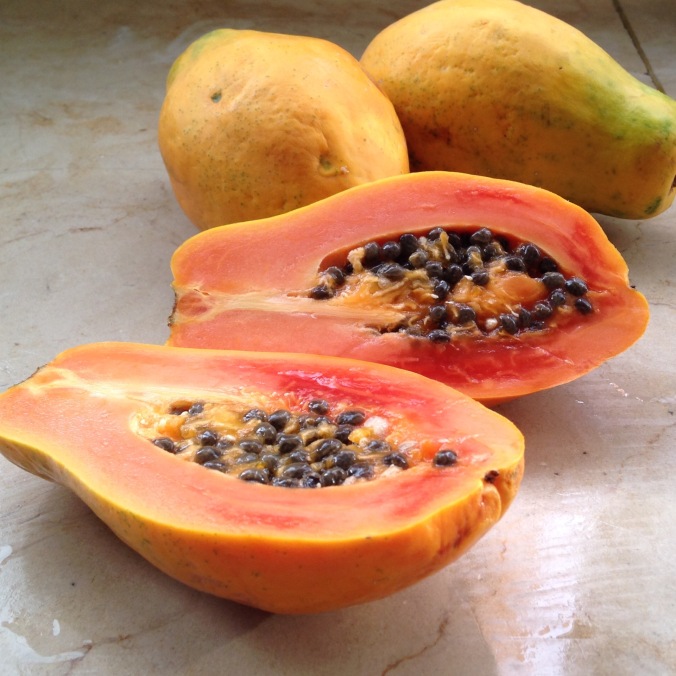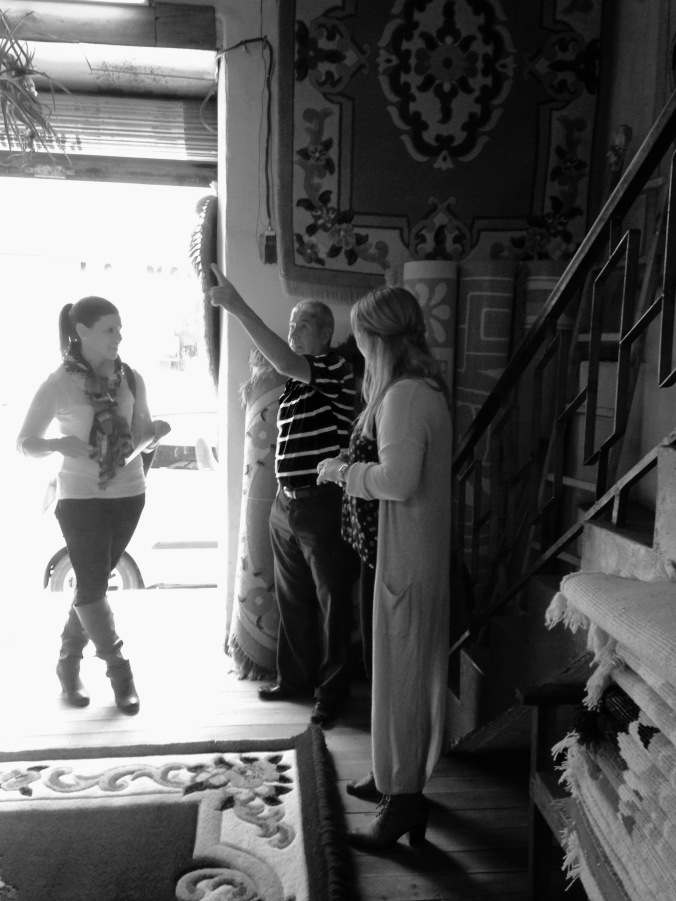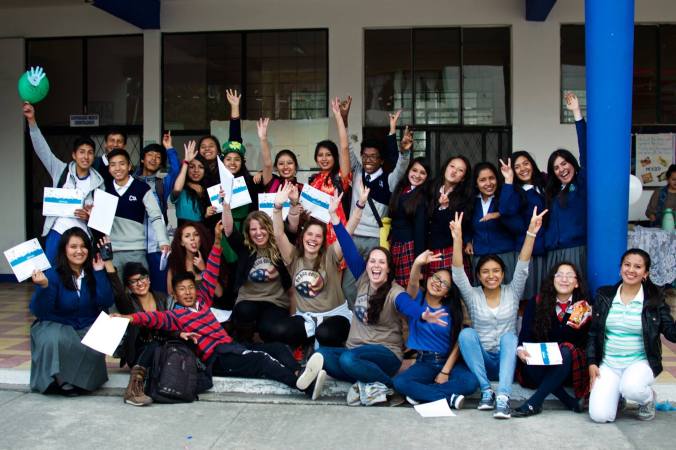We’re doing English Club again this semester, and this time the focus is on U.S. regions and holidays. For Halloween we threw a themed party with costumes, mask making, babaco (a typical fruit) carving, games like pin the spider on the web and apple bobbing, and, of course, trick or treating. Overall, it was hit and a lot of fun for both the students and teachers!
peace corps
A Day in the Life of a TEFL Volunteer: English Immersion Camp
It’s “summer break” in the Sierra – though on the Equator seasons as we know them in the USA don’t exist – which means many volunteers are busy planning and leading camps for students. Personally, I’m involved in three camps this break, including one which I am coordinating at my school with the other Ambato volunteers.
However, the highlight for many volunteers is the annual US Embassy sponsored English immersion camp. The US Embassy offers a two-year intensive English language program to underserved Ecuadorian students, and each summer the students are invited to a 3 day immersion camp to practice with native speakers and have fun. The embassy invited Peace Corps to collaborate, so volunteers serve as the camp counselors. It’s exhausting and full of long days, but ultimately it is a very rewarding experience for us to watch the teens open up and have fun with their second language!
The camp was held in beautiful Mindo, a cloud forest nestled in the mountains between the highlands and coast regions, about two hours northwest from Quito. The theme this year is the environment, and campers were split into five teams: Recycling, Oceans and Coasts, Rainforest, Endangered Species, and Waste Management – I was part of the oh-so glamorous Waste Management team.
Here is a glimpse at a typical day during what we lovingly called Camp Mindo:
6:45 AM: My alarm goes off, and I get ready for the day. I slather on sunscreen and bug repellant, and head out to the resort reception area – the only WiFi spot – to check my email.
8:15 AM: The counselors meet with the camp leaders to review the day’s agenda and answer any questions. Afterward, we head into the cafeteria for breakfast.
9:00 AM: This morning the campers have pool time for a couple of hours. The counselors join in on the fun for a bit, but mostly we sit poolside to chat and enjoy the sun. A benefit of camp for the PCVs is not only the chance to visit new locations, but also to meet volunteers from other omnibuses, or training groups.
11:15 AM: After a bit of effort to get the campers out of the pool and dressed, we meet up in front of the reception area to depart for the butterfly farm that is also part of the resort. When we arrive to the farm, we split the group into two – half will learn about how to make origami butterflies they can string up as a mobile, and the other half will go to the farm to learn about the lifecycle of butterflies and see a few species up close and personal.
Culture Club (not the band)
The Peace Corps has three goals that are universal to all volunteers:
- To help the people of interested countries in meeting their need for trained Volunteers.
- To help promote a better understanding of Americans on the part of the peoples served.
- To help promote a better understanding of other peoples on the part of Americans.
The first goal I accomplish day to day as a trained TEFL volunteer working with Ecuadorian teachers. The third goal I accomplish by writing this blog. And the second goal I accomplished by co-coordinating an amazingly fun English Club with my fellow Ambato volunteers.
Last semester we offered an 8-week English Club to high school students from across Ambato. The theme was “US Culture,” which is extremely broad, so we narrowed it by focusing on other cultures that have influenced the US through immigration. Many Ecuadorian students were surprised to learn about the variety of cultures that make up the overall US culture. We focused on Mexican, Indian, British, and Chinese influences.
Each week we highlighted one of the above cultures, shared some facts about their influence, and then split into groups to rotate through different hands-on learning stations. The club culminated in an Open House to showcase what we learned – and it was a big success!
Fruits of Ecuador: Papaya
First of all let me just say that I hate the taste of papaya. I knew this going into buying a bundle of five of them. So, why did I bother? Because – ALERT overshare about to happen ALERT – I thought I had parasites.
Supposedly papaya and its seeds are good for improving the flora and fauna of your intestinal track. At least that is what the internet told me. I figured I’d give it try because that’s what every Peace Corps Volunteer who does not want to travel to visit the medical office does. In hindsight I think I only had a run of the mill virus because my symptoms cleared up after about two weeks, but who knows. Maybe it was the wonder of papaya!
 Papaya is very popular in Ecuador, and it is sold in both big and small varieties. If I’m going to eat papaya, I prefer the smaller variety because it is usually sweeter… and there is less of it. You can buy a bundle of 5-6 of the fruits for $1 at the farmers market here.
Papaya is very popular in Ecuador, and it is sold in both big and small varieties. If I’m going to eat papaya, I prefer the smaller variety because it is usually sweeter… and there is less of it. You can buy a bundle of 5-6 of the fruits for $1 at the farmers market here.
To make the fruit a little more palatable, I incorporated it into my typical breakfast. A benefit of living in Ecuador is the access to affordable, wholesome foods. Most mornings I have a bowl of fresh fruit, plain yogurt, chia seeds, and granola with nuts and dried fruits. It’s a tasty way to start the day, and it all costs about 75 cents per bowl.
And if you happen to be wondering about the seeds, they have a kick to them. I tried one spoonful and would describe the flavor as like black pepper.
Guano: Meet Gerard, the Rug Maker

While visiting Guano my fellow Peace Corps Volunteer, Erin, who lives in Riobamba and has visited before, suggested we check out the workshop of Gerard, a rug maker. She had a picture from another volunteer of a family heirloom rug that was damaged in a flood, and she hoped Gerard might be able to replicate it.
Gerard’s modest workshop is located on a corner by the park. When we arrived, he greeted us warmly and asked from where we were visiting. Erin stepped up and explained how they had met once before and how she was hoping he could help her with the project. Gerard’s eyes beamed and he invited us in to talk.
 The first floor of his workshop is decorated with his designs. Hanging from the walls are large, hand woven rugs on display and stacked along the back were smaller versions. The smaller versions were about 2 feet by 3 feet in size and priced around $30. The larger designs went up to a couple hundred dollars each. I browsed the designs while Erin chatted, and then she asked Gerard if he would mind showing us his workspace like he had for her before.
The first floor of his workshop is decorated with his designs. Hanging from the walls are large, hand woven rugs on display and stacked along the back were smaller versions. The smaller versions were about 2 feet by 3 feet in size and priced around $30. The larger designs went up to a couple hundred dollars each. I browsed the designs while Erin chatted, and then she asked Gerard if he would mind showing us his workspace like he had for her before.
Gerard led us up the stairs to his lofted workspace. On the far end stood his loom and next to it were spools of hand dyed wool and rolled up design sketches. He explained that he has designed rugs for government officials throughout Ecuador as well as for ambassadors from other countries. He unrolled a small version of the design he made for the ambassador from Peru. Also, when the Pope visited Ecuador in July, he was invited by the Vatican to produce a rug. He proudly unrolled the large sketched design he made of the papal seal. It took him about 3 days to sketch the grid he would follow, then a couple months to construct the rug.
He explained his process for us, from first imagining an image, then converting it into a grid design. He follows his grid to know when to change wool colors as he works row by row on the loom. When he finishes the rug, he uniformly trims the yarn with his well-worn scissors.
Guano has a long tradition of making rugs, but as the economic climate
changed, the art has slowly faded. Gerard explained that he is one of only a few rug makers in town still making designs and rugs by hand. The craft has been in his family for generations, and he commented that his grandparents died making rugs, his parents died making rugs, and he plans to die making rugs. It is his art and his passion, and it shines through in each of his carefully made pieces.

Guano: A Gem in the Andes
A few months ago I was invited to the small town of Guano with some other volunteers to provide training on TOEFL test-taking strategies. First of all, just getting to Guano was a very “Ecuadorian” experience for me. I took an interprovincial bus (between the provinces of Tungurahua and Chimborazo) to Riobamba then a taxi to the intercantonal bus terminal that goes to the counties of Chimborazo. I was hungry by the time I arrived, so for $1 I bought a pincho, or kebab of grilled meat, sausage, and potato, and then realized that the crowd of people boarding an unmarked bus was heading to Guano.
I hopped on with pincho in hand, and because there were no more seats, I sat down next to an older gentleman on what was essentially a bean bag chair plopped down at the front. The bus filled to the brim, so much so that the driver had to climb over passengers to get into his seat. His bus seemed to be his pride. The interior around his seat was cozy and decorated with numerous religious images and figurines of the Virgin Mary, an Ecuadorian flag, beaded tassel curtains, and more. We set off on the 30 minute ride to Guano. Along the way, if a passenger wanted to get off, they would simply call out “Gracias!” and hand over their fare. If the driver was slow to stop, the gracias got a little more persistent, but never rude. The older gentleman next to me was kind, telling me the cost of my fare and pointing out my stop as we neared. I handed over my 30 cents and got off at the park in the center of town.
Like most small Ecuadorian towns, the park is the heart of town. Along its perimeter are the church, the municipal building, the bank, and small businesses. Within just a short walk were my hostel and the local Ministry of Education district office that was hosting our training. The park itself is nicely landscaped with a winding walking path, as well as this beauty of a tree. At night the letters are aglow with twinkle lights.
Home Sweet Home

Those who have traveled to live, work, or study abroad for an extended period of time understand how complicated the word “home” can become. Does it mean where you grew up? Where you live now? Where your family or friends are? Home can change and mean different things throughout life. For me, I’ve had a few homes – and some that never quite felt like it – but, Ecuador, and Ambato in particular, feels like a home that will always be special to me thanks to my host family and Ecuadorian friends who have made it such.
It took a while to get to this place, and in the meantime, it’s helped to surround myself with the little things that bring me comfort and remind me of the homes I’ve had before.
In no particular order, here is a list of some of the little things that have helped me feel at home here.
- Cozy pillow. Some of my family scoffed when they saw me struggling to vacuum seal my favorite pillow so it would fit in my already over stuffed suitcase, but I stand by the decision. Many of the pillows here are hard and flat, so my super soft one is a welcome comfort. Plus, a good night’s sleep makes all the difference!
- Laptop to stay connected. The Peace Corps packing list warned against bringing a laptop and other expensive electronics, but it is such a necessity as a TEFL volunteer – and to stay in touch with family and friends! Also, I have reliable internet connection at home, which means Facebook and Netflix all night long when I’m feeling bored.
- Photos/Notes from family and friends. Not only do they spark warm memories, but they also are great as decor on what otherwise would be some very bare wall. I keep a gallery wall of the postcards and letters I’ve received since arriving.
- A fur-friend. Obviously a pet can be a welcome friend on those days you’re feeling alone, but it’s also a great way to bond with host family. My host sister and I have grown so much closer caring for our hamster, Estuard, and now our cat, Bruno.
- Treating myself to my favorite touches. One such touch is fresh flowers. I think they instantly brighten a room and make it feel welcoming. Fortunately, fresh flowers won’t break the bank either. Ecuador is one of the world’s leading rose producers, and a bouquet of 6 costs only $1.
- Souvenirs from both here and there. Souvenirs from the US, such as a bedazzled map with my favorite road trip stops or a keychain from California, are nice reminders of my home stateside. But, also, souvenirs from Ecuador have added color and fun memories to my room. I love the pattern and warmth of the wool blanket I got from the artisan market in Quito or the rainbow grin of the diablo huma mask I found in Baños on a date.
These are some of the material things that have made my home away from home warm, but the relationships I’ve made here are what really matter.

On another note I am a featured blogger at Blogging Abroad, a great resource for promoting culture sharing through blogging. This post was inspired by their monthly photo challenge, the latest theme being “home.” Follow me on Instagram @awecuador to get a glimpse at my daily life abroad.
Fruits of Ecuador: Pitahaya Roja
First of all, there happen to be two kinds of pitahaya in Ecuador: roja and amarilla. This post is about pitahaya roja, or dragon fruit. I’ll get to amarilla another day.
Growing up in California where there is a large Asian population, dragon fruit was not uncommon to find in local supermarkets. However, I was a little surprised to find it at the local farmers markets here in Ecuador! Again, like achotillo, I’m not sure how this fruit came to Ecuador, though I’m sure it was imported at some point. Although I’ve seen dragon fruit most of my life at the market, I’d never actually bought and tried it until now. I’ve always marveled at the bright fuchsia color of the skin and the green spikes.
And the inside is just as fascinating. Cut it open and you’ll find a white, watery flesh like in a melon that is speckled with black seeds. The taste is pretty mellow, like a bland cross between melon and kiwi. Here it’s used to make fresh juice or sometimes cut up for fruit salad with yogurt and granola.
Also, an interesting fact I learned while researching more about pitahaya is that it is a cactus fruit! I didn’t know… its cactus plant has a stump with several thin, long spiky branches that hang over it like a palm tree, and the fruit grows at the tips of the branches.
A Day in the Life of a TEFL Volunteer: Teacher Trainings
The majority of my time is spent in Ambato at my high school, but occasionally I have the opportunity to travel to help other volunteers or the Ministry of Education provide trainings to English teachers. Teacher trainings are a great way to see other parts of the country as well as visit my fellow volunteers. As such, most of us jump at the opportunity to participate. This year I’ve already done 3 – in Ibarra, Guano, and Portoviejo – and I have a fourth one planned for the end of this month in Ambato (it’s my turn to host apparently).
Here’s a glimpse at a typical day during a teacher training, inspired by my most recent experience in Portoviejo.
6:00 AM: The first of the alarm clocks rings. I am sharing a hostel room with five other volunteers because it was the only option in our budget.
6:30 AM: My alarm clock rings, and I get up to take a shower and get ready for the day. I finally have a reason to wear a dress to work because on the coast it is usually humid and hot unlike in the sierra where I live.
7:05 AM: We all pack our bags for the day and head out to meet Zack, our fellow Peace Corps volunteer and host, at his apartment.

The perfect way to start the day!
7:20 AM: We find an open restaurant and sit outside for breakfast. I order a simple, filling meal of bolon with a fried egg and coffee. Bolon is typical on the coast and is made from boiled, mashed green plantain formed into a ball and filled with cheese and chicharron, or bits of pork. This restaurant serves them fried, and I love the crunch of it smothered in egg yolk.
8:10 AM: We share taxis across town to the school where the training will be held. We worry a bit that only a handful of teachers will come because the notice email from the local school districts was sent only the night before. Continue reading
How to Make Llapingachos
I’ve mentioned llapingachos, or potato pancakes with chorizo and egg, on this blog several times because they have become my comfort food here in Ambato. Whenever someone comes to visit, I take them to the local market for a $2 plate. I tried making a batch for my friends and family in the US over Christmas break, and although they were good, they didn’t have the full flavor of my host mom’s here.
Over Easter break, she and my cousin made a big batch for the whole family, and my mom walked me through the process. I finally learned the secret to the added flavor – plenty of aliños, or spices/dressing, and the drippings from the chorizo! Of course; just add fat.
They are super easy to make, so I recommend you try! Here’s a short video I made to give you an idea of how:










































